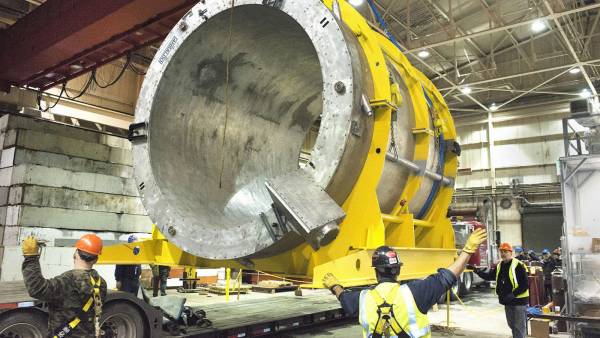Project 9
Project 9A: Detecting magnetic fields
An experimental magnetic field detector has been constructed outside of the town of Lakeview. Although the purpose of the detector is largely unknown to the townsfolk of Lakeview you and your team have been recruited to develop a magnetic field detector that is able to detect Hawkions. Hawkions are like muons, but are slow-moving and have long lifetimes. They are a newly discovered top secret particles that the data from the probe from Artemis 13 discovered is bombarding the Lakeview area. You have a somewhat constructed model, in which the Hawkions follow a straight line trajectory, but it looks like there are some pieces of code that the team wasn't sure what to do with. You will need to select a few locations to model the magnetic field due to the Hawkions and produce arrows that represent the Hawkion's magnetic field. Best hurry, the government needs more information about the Hawkions particle before it is too late.
## Scene setup scene.background = color.white ## Parameters and Initial Conditions velocity = vector(1,0,0) ## Objects charge = sphere(pos=vector(-2,0,0), radius=0.1, color=color.blue) xaxis = cylinder(pos=vector(-3,0,0), axis=vector(6,0,0), radius = 0.01, color=color.black) yaxis = cylinder(pos=vector(0,-3,0), axis=vector(0,6,0), radius = 0.01, color=color.black) zaxis = cylinder(pos=vector(0,0,-3), axis=vector(0,0,6), radius = 0.01, color=color.black) ## Calculation Loop t = 0 dt = 0.01 while t < 5: rate(100) charge.pos = charge.pos + velocity*dt t = t + dt ## Not sure what to do with these ##p = sphere(pos=vector(-1,-1,0), radius = 0.1, color=color.cyan) ##Barrow = arrow(color=color.red) ##Barrow.pos = p.pos ##Barrow.axis = vector(0,0,0)
Learning Goals
- Visualize the magnetic field from a single moving charge
- Use the right hand rule to predict the direction of the magnetic field
- Understand how to use a cross product conceptually and mathematically
- Explain the similarities and differences between electric and magnetic fields
Conceptual Questions:
- What shape is the magnetic field around the moving point charge? (Hint: make multiple observation points and move them around)
- How is magnetic field different than electric field?
- How would you calculate the magnetic field? (Pick an observation point and do a sample calculation)
- What is a cross product? What role does it serve in the magnetic field equation?
- What is a “normal” size for magnetic fields? (Look up how big is Earth's magnetic field, fridge magnet, etc.)
- What assumptions did you make for the problem? How would you evaluate your answer?
Project 9B: Sorting Hawkions
Since your team was so successful at creating the magnetic field detector for the Hawkions, the Lakeviewians have now hired you to analyze other characteristics of the Hawkions. The Hawkions appear to have a variety of masses, so you start by trying to sort the Hawkions by mass for further analysis (using a mass spectrometer). Before building the spectrometer, your team is asked to develop a model of the spectrometer. The higher ups have specified that they would like to use a constant magnetic field of 2 T and to isolate the effects of the B-field within the magnetic housing box, but they are unsure what direction the magnetic field should be relative to the catching plate. Below is the beginning of a model that was developed by another team that mysteriously disappeared.
GlowScript 3.0 VPython ## Model parameters B = vec(0,0,0) ## Objects mag_housing = box(pos=vec(1,0,0), length=2, height=2, width=2, opacity=0.2) catchingplate = box(pos=vec(4,0,0), length=0.1, height=10, width=10, opacity=1) xaxis = cylinder(pos=vector(-3,0,0), axis=vector(6,0,0), radius = 0.05, color=color.white) yaxis = cylinder(pos=vector(0,-3,0), axis=vector(0,6,0), radius = 0.05, color=color.white) zaxis = cylinder(pos=vector(0,0,-3), axis=vector(0,0,6), radius = 0.05, color=color.white) ## Set up particles i = 0 N = 20 particleList = [] while i < N: particleList.append(sphere(pos=vec(-2-4*random(),0,0), radius = 0.1, m = 20*(random()+1), v = vec(2,0,0), q = 10, color=color.red)) i = i + 1 ## Calculation Loop t = 0 dt = 0.01 while t < 30: rate(300) for thisParticle in particleList: thisParticle.pos = thisParticle.pos + thisParticle.v*dt if thisParticle.pos.x > catchingplate.pos.x: thisParticle.v = vector(0,0,0) t = t + dt
Learning Goals
- Use the right hand rule to relate the charge's velocity and external magnetic field to the force on that charge.
- Use circular motion to relate the radius of the particle's trajectory to it's force
- Understand what an “if statement” does in the code
Conceptual questions:
- How is the right hand rule for magnetic field different from the right hand rule for magnetic force?
- Which of your particles are the heavier particles and which are the lighter ones? How do you know?
- What does an “if statement” in the code do?
- You calculated the force in the code, which has to be from something and on something. What is the force from and what is it on in the code?
- Why do you get circular motion for the particles?
- How would you calculate the magnetic force on a charge? (Pick an magnetic field & charge velocity and do a sample calculation)
